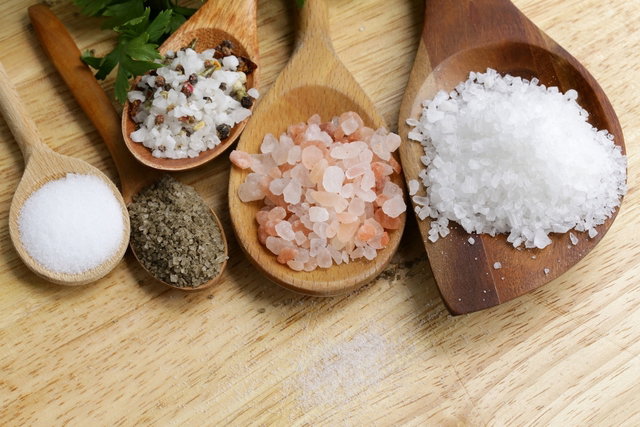Salt, also known as sodium chloride (NaCl), provides 39.34% sodium and 60.66% chlorine. Depending on the type of salt, it can also provide other minerals to the body.
The amount of salt that can be consumed daily is around 5g, which is equivalent to 5 packets of 1g salt or a teaspoon. The healthiest salt is the one with the lowest sodium concentration, as this mineral is responsible for increasing blood pressure and promoting fluid retention.
Another important point when choosing the best salt is to opt for those that are not refined, as they preserve natural minerals and do not add chemical substances, such as Himalayan salt, for example.

Types of salt
The table below indicates the different types of salt, what their characteristics are, how much sodium they provide and how they are used:
Processed foods contain large amounts of sodium, even soft drinks, ice cream or cookies, which are sweet foods. Therefore, it is recommended to always read the label and avoid consuming products with amounts equal to or greater than 400mg of sodium per 100g of food, especially in the case of hypertension.
How to consume less salt
Regardless of the salt used in the kitchen, it is important to use the smallest amount possible. So, to reduce your salt intake, try:
- Remove the salt shaker from the table;
- Do not add salt to food without trying it first;
- Avoid consuming bread and processed foods, such as packaged snacks, French fries, powdered and diced seasonings, ready-made sauces and sausages, such as sausage, ham and nuggets;
- Avoid consuming preserved foods, such as olives, hearts of palm, corn and peas;
- Do not use monosodium glutamate, present in Worcestershire sauce, soy sauce and ready-made soups;
- Always use a coffee spoon to measure the salt instead of pinches;
- Replace salt with natural seasonings, such as onion, garlic, parsley, chives, oregano, coriander, lemon and mint, for example, or, at home, grow aromatic plants that replace salt.
Another strategy to replace salt in a healthy way is to use gomasium, also known as sesame salt, which has a low sodium content and is rich in calcium, healthy oils, fiber and B vitamins.
Watch the video and learn how to make homemade herb salt to reduce your salt consumption in a tasty way:
Bibliography
- CARAPETO Cristina; BRUM Silvia et al. Which Table Salt to Choose? . Journal of Nutrition & Food Sciences. 8. 3; 1-4, 2018

Sign up for our newsletter and stay up to date with exclusive news
that can transform your routine!
Warning: Undefined array key "title" in /home/storelat/public_html/wp-content/plugins/link-whisper-premium/templates/frontend/related-posts.php on line 12
Warning: Undefined array key "title_tag" in /home/storelat/public_html/wp-content/plugins/link-whisper-premium/templates/frontend/related-posts.php on line 13




